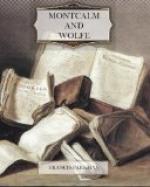[Footnote 319: Review of Military Operations in North America, in a Letter to a Nobleman (ascribed to William Livingston).
On the Battle of Lake George a mass of papers will be found in the N.Y. Col. Docs., Vols. VI. and X. Those in Vol. VI., taken chiefly from the archives of New York, consist of official and private letters, reports, etc., on the English side. Those in Vol. X. are drawn chiefly from the archives of the French War Department, and include the correspondence of Dieskau and his adjutant Montreuil. I have examined most of them in the original. Besides these I have obtained from the Archives de la Marine and other sources a number of important additional papers, which have never been printed, including Vaudreuil’s reports to the Minister of War, and his strictures on Dieskau, whom he accuses of disobeying orders by dividing his force; also the translation of an English journal of the campaign found in the pocket of a captured officer, and a long account of the battle sent by Bigot to the Minister of Marine, 4 Oct. 1755.
I owe to the kindness of Theodore Pomeroy, Esq., a copy of the Journal of Lieutenant-Colonel Seth Pomeroy, whose letters are full of interest; as are those of Surgeon Williams, from the collection of William L. Stone, Esq. The papers of Colonel Israel Williams, in the Library of the Massachusetts Historical Society, contain many other curious letters relating to the campaign, extracts from some of which are given in the text. One of the most curious records of the battle is A Prospective-Plan of the Battle near Lake George, with an Explanation thereof, containing a full, though short, History of that important Affair, by Samuel Blodget, occasionally at the Camp when the Battle was fought. It is an engraving, printed at Boston soon after the fight, of which it gives a clear idea. Four years after, Blodget opened a shop in Boston, where, as appears by his advertisements in the newspapers, he sold “English Goods, also English Hatts, etc.” The engraving is reproduced in the Documentary History of New York, IV., and elsewhere. The Explanation thereof is only to be found complete in the original. This, as well as the anonymous Second Letter to a Friend, also printed at Boston in 1755, is excellent for the information it gives as to the condition of the ground where the conflict took place, and the position of the combatants. The unpublished Archives of Massachusetts; the correspondence of Sir William Johnson; the Review of Military Operations in North America; Dwight, Travels in New England and New York, III.; and Hoyt, Antiquarian Researches on Indian Wars,—should also be mentioned. Dwight and Hoyt drew their information from aged survivors of the battle. I have repeatedly examined the localities.
In the odd effusion of the colonial muse called Tilden’s Poems, chiefly to Animate and Rouse the Soldiers, printed 1756, is a piece styled The Christian Hero, or New England’s Triumphs, beginning with the invocation,—




